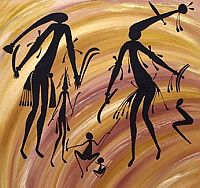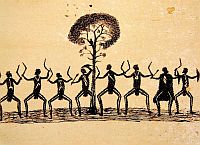


|
|
AustraliaStar Lore
|
|


|
|
The Boorong are one of twenty clans of the Wergaia language group in north-western
Victoria. The were accomplished star-gazers with a sophisticated knowledge of astronomy. Living relatively close to both Sydney and Melbourne, they
became the most intensively studied Australian Aboriginal nation when it comes to star lore and astronomy.
 The extensive material about Boorong star lore warranted the creation of an individual page. For a collection of other Aboriginal star lore, see our Australian Aboriginal site.  The studies of Boorong astronomy referred to in this presentation are:  Dianne Johnson: Night Skies of Aboriginal Australia Edward Stanbridge Esq.: On the Astronomy and Mythology of the Aborigines in Victoria John Morieson B.A: The Night Sky of the Boorong Museum of Victoria: Stories in the Stars ľ the night sky of the Boorong people Wikipedia: Wergaia - Mythological_and_empirical_thinking |
 Boorong Planisphere
Boorong PlanisphereSource: researchgate.net |



|
|
Aquila
The Boorong called Altair (α Aquilae) Totyarguil, which is also
the name of the Purple-crowned Lorikeet. The two stars to his side,
Alshain (β Aquilae) and
Tarazed (γ Aquilae) are his wifes.
|

|


|
|
Auriga
The Boorong called Capella (α Aurigae) Purra, the Kangaroo that is
been hunted by Yurree (Castor, α Gem) and Wanjel
(Pollux, β Gem).
|
 Kangaroo
Kangaroo© Francis Firebrace |


|
|
Bo÷tes
The Boorong call
Arcturus (α Bo÷tis) Marpeankurrk.
|
 Honey Ant
Honey AntSource: artyfactory.com
|


|
|
Canis Major
To the Boorong,
Sirius (α Canis Majoris), the brightest star in the night sky is the center of
the constellation Warepil, the male wedge-tailed eagle,
chief of the Nuh-rum-bung-goo-tyas, the
elders who created the land.
|

|

Also in Boorong lore, σ Canis Majoris was a man named Unurgunite, flanked by his wifes
Wezen (δ Canis Majoris) and
Adhara (ε Canis Majoris).
 In the natural world of the Boorong, Unurgunite is a poisonous lizard called Nyurgen-nyurgen-djine literally "bitten-bitten-foot."  In 2017, the IAU approved Unurgunite as the official name of σ Canis Majoris. |
 Lizard
Lizard© Francis Firebrace |
 The Boorong have lived in what is now north-western Victoria for at least 1,600 generations and their oral history, including their star lore dates back perhaps ten thousand years or more.  With that in mind, Unurgunite may very well be the oldest star name still used.  Sources: Morieson, Wikipedia, theconversation.com, Australian Broadcasting Corporation |


|
|
Capricornus
The Boorong see the double star Algiedi Prima (α1 Capricorni) and
Algiedi Secunda (α2 Capricorni) as the fingers of
Collenbitchick, feeling for the bank of the river.
|

|
Most likely, Collenbitchick was associated with some kind of ant or termite, which would explain his mythical healing powers.
Popular legend tells a story of Aboriginals using ants to stitch cuts together by holding the two sides of a wound together and then
encouraged an ant to bite and embed its pincers in either side of the wound, which would then close up.
 Source: Morieson |


|
|
Carina
The usually dim star (or rather star system) η Carinae is surrounded by a nebula, that makes its
magnitude vary rapidly. Starting in 1827, the star started getting brighter. Between March 11 to 14, the star's magnitude surpassed that of
Canopus (α Carinae), before falling back to beyond naked-eye visibility.
|

|


|
|
Coma Berenices
The Boorong call the faint constellation Coma Berenices Tourtchin Boionggerra, "Stars of the Needlewood" and see them as a small flock
of birds drinking rain water, which had lodged in a hollow in the fork of a tree.
|

|
Robert Mathews explains: "if a forked tree is split slightly open by a windstorm
when the tree is growing, the wood around it decays and rots forming a cavity in time in the bole of the tree. During rain, water runs down the
branches into the hollow until it fills. Such water remains for a long time being replenished by every shower."
 Source: Morieson p. 106 |


|
|
Corona Australis
The Boorong call the constellation Corona Australis Won, the boomerang.
|
 Boomerang
BoomerangSource: artyfactory.com |
 Old records left an uncertainty weather the constellation Corona Australis or Corona Borealis represents that boomerang. Both constellations have the shape of a boomerang, but since Corona Australis is always in the sky at the same time as Altair, it has been identified by Morieson as the constellation in question. |


|
|
Crux and
Centaurus
The Boorong tell the story of Bunya, who was chased by the emu Tchingal.
|
 Opossum Tree
Opossum Tree© Narritjin Maymuru |

|
|
Coalsack Nebula
Many Australian Aboriginal nations see the dark patches in the milky between the Southern Cross and Scorpius as a giant Emu (in fact, half a world away,
in South America, many nations see a similar bird in the same figuration).
|
Tchingal is the giant emu that eats people and therefore made families live in constant fear of their lives. The crow grew tired of the
constant harassment and told of his dread to the Berm-Berm Gle brothers (the pointer stars
Alpha and Beta Centauri). They promised to help him if crow would lead them to the fearsome giant.
 The ensuing battle raged over a wide region, which helped to define the current landscape and ultimately their quarry was cornered. To their surprise it was the Singing Bush lark, Weetgurrk (Zeta Bo÷tis), that delivered the deathblow, the final spear thrust, which secured the future safety for all people.  The heroic brothers then split each feather of the giant emu down the middle, casting one half of the feathers on the right hand side and the other half on the left, making two heaps. One of these heaps became the cock, the other the hen of the present race of emus, which are much, much smaller in size.  It was arranged that all future emus should lay a number of eggs instead of one only as the giant had. The splitting of the feathers is still easily observable in the twin-shafted feathers of all emus today.  On first sighting Tchingal in the night sky the observer is overwhelmed by its immensity. Its head is what other astronomers call the Coal Sack, just to the bottom left of the Southern Cross, its neck extends down through the pointers and its body is the large dark patch just before reaching Scorpius. Its legs hang down into the tail of Scorpius.  Source: Creativ Cowboy: Stars over Tyrell |
 Head of the emu
Head of the emuin the Coalsack Nebula (with Crux to the right) Source: Wikipedia
|


|
|
Delphinus The Boorong call the constellation Otchocut, meaning Great Fish. The great fish is the Murray cod, the largest exclusively freshwater fish in Australia. |
 Murray cod
Murray cod© Francis Firebrace |

A Boorong legend tells us about the great ancient warrior Totyarguil, who once spotted a monstrous cod fish in a water hole. He threw all of his spears
at the fish, but the fish got away, digging up a new waterway, which became the Murray River. the spines now found
projecting from the back of the cod fish represent the spears thrown by Totyarguil in his vain attempt to capture it.
 Source: Morieson p.97 |


|
|
Eridanus
The Boorong call Achernar
(α Eridani) Yerredetkurrk, which is also the name of the owlet nighgar, a small,
nocturnal bird. According to Robert Mathews, the owlet nighgar is the patron saint
of all women.
|

|

Another Boorong leged tell us about a feud between Yerredetkurrk and her son-in law:
 One time, Totyarguil's family was stuck on a mountain top that was too steep to climb down. Totyarguil called out to his wife and children to jump down, one by one, and he would catch them in his arms. He caught all of them safely, but when Yerredetkurrk jumped, he pretended he could not catch her, and she fell heavily on the ground. She recovered, but surely held a grouch.  Some time late, Yerredetkurrk spotted a vicious creature in a water hole. She covered the hole over with leaves and grass to resemble a huge bandicoot's nest. She then tricked Totyarguil to enter the nest to retrieve the animals. Totyarguil fell into the water hole and the monster at the bottom caught hold of his feet and drowned him. Luckily for Totyarguil, his uncle Collenbitchick came to his rescue and managed to revive him.  Source: John Morieson B.A: The Night Sky of the Boorong |


|
|
Gemini
The Boorong see two unlikely
brothers in the constellation known in the West as Gemini.
|

|


|
|
Jupiter
The Boorong call Jupiter Ginabongbearp, meaning "Foot of Day." He is the chief ot the ancient spirits called Nurrumbunguttia and
the husband of Chargee Gnowee, which is Venus.
|


|
|
Lyra
The Boorong called
Vega (α Lyrae) Neilloan, the Malleefowl.
|
 Malleefowl
MalleefowlSource: Wikipedia |


|
|
Moon
The Boorong call the Moon Mityan. They tell the story of the feud between Mityan and Unurgunite.
|


|
|
Orion
The Boorong tell the story of the Kulkunbulla, a group of young men dancing a
dance called corroboree.
|
 Kulkunbulla
KulkunbullaMuseum of Victoria |


Rigel (β Orionis), the brightest star in the constellation Orion and the seventh brightest star
in the night sky is called Collowgullouric Warepil, wife of Warepil by the Boorong.
 Warepil is the name of the wedge-tailed eagle, chief of the Nuh-rum-bung-goo-tyas, the elders who created the land. Her husband is Warepil, represented by the brightest star in the night sky, Sirius (α Canis Majoris).  Source: Morieson |
 Wedge-tailed eagle
Wedge-tailed eagle©: Deb Easton |


|
|
Pleiades
In Boorong mythology, the Pleiades are a group of young women called Larnankurrk.
|
 Source: Aboriginal Art Library
Source: Aboriginal Art Library
|


|
|
Scorpius
Antares (α Scorpii) is called Djuit by the Boorong. He is the son of Marpeankurrk,
which is Arcturus (α Bo÷tis). |
 Red-rumped parrot
Red-rumped parrotSource: Wikipedia |

The two stars at the end of the scorpio's tail, Shaula (λ Scorpii) and
Lesath (υ Scorpii) are a male and a female Kestrel
(a kind of falcon), called Karik Karik.
 The stars are directly overhead in the early evening in August, when the kestrel start laying their eggs.  Source: Stanbridge |
 Australian Kestrel
Australian KestrelSource: Wikipedia |
|
|
Sun
The Boorong call the Sun Gnowee.
|

Another Nation of the Wergai language group, the Wudjubalug people tell a somewhat different story:
 [Wikipedia Quote:] "Gnowee, the sun, was created by Pupperimbul, one of the Nurrumbunguttia. These ancient spirits disappeared from the heavens before man himself was created, and the earth was in sheer darkness. Pupperimbul hurled an emu egg into the firmament, whereupon it burst and shed light over the sky.  Source: Wikipedia, quoting Roslynn D. Haynes: "Astronomy and the Dreaming: The Astronomy of the Aboriginal Australians" |
 Carved Emu Egg
Carved Emu Egg©: Australian Museum |


|
|
Taurus
Gellarlec is an old man, represented by Aldebaran (α Tauri). In Boorong tradition,
Gellarlec chants and beats time to the dance of the Kulkunbulla (Orion's Belt) and
Larnankurrk (Pleiades).
|
 Dancers
Dancers©: Tommy Barnes |


|
|
Venus
The Boorong call Venus Chargee Gnowee, meaning Sister of Gnowee, which is the Sun.
|


|
Back to Star Lore |
Back to Mythology |
Back to Space Page |
Back to English |
 Back to Start Page |